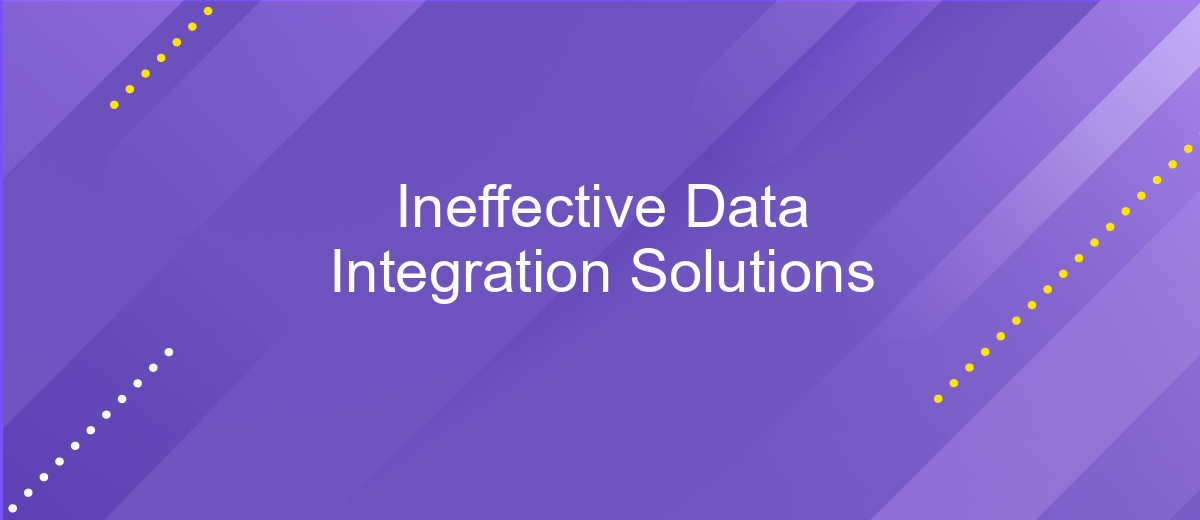Ineffective Data Integration Solutions
In today's data-driven world, effective data integration is crucial for business success. However, many organizations struggle with ineffective data integration solutions that lead to fragmented information, inefficiencies, and missed opportunities. This article explores the common pitfalls of inadequate data integration strategies and provides insights into how businesses can overcome these challenges to harness the full potential of their data.
Common Challenges with Data Integration Solutions
Data integration is crucial for businesses aiming to leverage multiple data sources, but it comes with its own set of challenges. These challenges can hinder the efficiency and effectiveness of data integration solutions, leading to suboptimal decision-making and operational inefficiencies.
- Data Quality Issues: Inconsistent, duplicate, or incomplete data can lead to unreliable insights.
- Scalability Concerns: As data volumes grow, integration solutions may struggle to keep up, affecting performance.
- Compatibility Problems: Different data formats and systems may not seamlessly integrate, requiring complex transformations.
- Security Risks: Integrating data from multiple sources can expose sensitive information to security vulnerabilities.
- High Costs: Implementing and maintaining robust data integration solutions can be expensive and resource-intensive.
Addressing these challenges requires a comprehensive strategy that includes robust data governance, scalable architecture, and ongoing monitoring. By proactively managing these issues, businesses can ensure more reliable and efficient data integration processes, ultimately driving better outcomes.
Risks of Ineffective Data Integration Implementations

Ineffective data integration implementations can pose significant risks to an organization. One major risk is the creation of data silos, where information is isolated in different systems, making it difficult to obtain a unified view of the data. This fragmentation can lead to inconsistent and inaccurate data, which in turn can result in poor decision-making and operational inefficiencies. Additionally, the lack of seamless data flow can hinder real-time analytics, making it challenging to respond promptly to market changes and customer needs.
Another critical risk is the potential for increased operational costs. Inefficient data integration often requires manual intervention to correct errors and inconsistencies, consuming valuable time and resources. Moreover, without a reliable integration solution like ApiX-Drive, which automates data workflows between various applications, businesses may find themselves investing heavily in IT support and custom development. This not only strains the budget but also slows down the overall business processes, affecting competitiveness and growth. Properly implemented data integration solutions are essential for maintaining data integrity, reducing costs, and enhancing operational efficiency.
Consequences of Poorly Integrated Data

Poorly integrated data can have far-reaching consequences for businesses, impacting everything from operational efficiency to decision-making processes. When data from various sources is not seamlessly combined, it leads to inconsistencies and inaccuracies that can undermine the reliability of insights derived from it.
- Operational Inefficiencies: Disjointed data systems require manual intervention to reconcile differences, wasting valuable time and resources.
- Inaccurate Reporting: Misaligned data can result in erroneous reports, leading to misguided strategies and business decisions.
- Customer Dissatisfaction: Inconsistent data can affect customer service, causing delays and errors that frustrate clients.
- Regulatory Risks: Poor data integration can lead to non-compliance with industry regulations, exposing the business to legal penalties.
- Lost Opportunities: Fragmented data hampers the ability to identify trends and opportunities, potentially losing competitive advantage.
Addressing data integration issues is crucial for maintaining the integrity and usefulness of business information. Investing in robust data integration solutions can significantly enhance operational efficiency, improve decision-making, and ensure compliance with regulatory standards. By doing so, businesses can better serve their customers and stay ahead in a competitive market.
Best Practices for Successful Data Integration

Successful data integration is crucial for businesses aiming to leverage their data effectively. To achieve seamless integration, it's essential to follow best practices that ensure data accuracy, consistency, and accessibility. By adhering to these guidelines, organizations can avoid common pitfalls and maximize the value derived from their data assets.
First and foremost, it's important to establish clear data governance policies. This includes defining data ownership, setting data quality standards, and implementing robust data security measures. Additionally, selecting the right tools and technologies that align with your business needs can significantly streamline the integration process.
- Define clear data governance policies
- Select appropriate tools and technologies
- Ensure data quality and consistency
- Implement robust data security measures
- Regularly monitor and update integration processes
By following these best practices, organizations can create a solid foundation for successful data integration. This not only enhances data reliability but also enables more informed decision-making and drives business growth. Consistent monitoring and updating of integration processes further ensure that data remains accurate and relevant over time.
- Automate the work of an online store or landing
- Empower through integration
- Don't spend money on programmers and integrators
- Save time by automating routine tasks
Case Studies and Examples of Ineffective Data Integration Projects
One notable example of an ineffective data integration project involved a large retail company attempting to merge customer data from various sources. The company underestimated the complexity of integrating disparate systems, resulting in significant data inconsistencies and loss. Despite investing heavily in software and manpower, the project failed to deliver a unified view of customer information, leading to poor decision-making and customer dissatisfaction.
Another case involved a healthcare organization that tried to integrate patient data across multiple platforms. The lack of a robust integration solution like ApiX-Drive led to frequent data mismatches and synchronization issues. Without an automated tool to streamline the data flow, the organization faced delays in accessing critical patient information, ultimately compromising the quality of care. These examples highlight the importance of choosing the right tools and thoroughly planning data integration projects to avoid costly failures.
FAQ
What are the common signs of ineffective data integration solutions?
How can ineffective data integration impact business operations?
What are the primary causes of data integration failures?
How can businesses improve their data integration processes?
What tools are recommended for effective data integration?
Time is the most valuable resource in today's business realities. By eliminating the routine from work processes, you will get more opportunities to implement the most daring plans and ideas. Choose – you can continue to waste time, money and nerves on inefficient solutions, or you can use ApiX-Drive, automating work processes and achieving results with minimal investment of money, effort and human resources.


